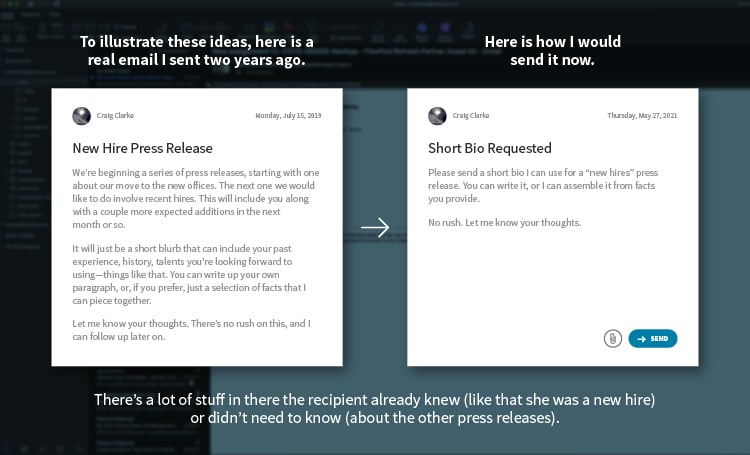Let’s face it. Nobody wants to read your emails.
It’s not personal.
They have other things to do, and your email is likely one of these two things:
- An interruption
- More work
Email is no longer for quick conversation. We use messaging (Slack, Teams, etc.) for that. We don’t send email unless it’s important.
Treat it that way. Communicate clearly. Because if you don’t, your email won’t get read. And, then, what was the point of sending it?
1. Don’t be so formal.
Business writing these days is too formal, full of stilted wording (“attached please find”), redundancy (“currently at this point in time”), or just plain clutter (“needless to say,” “the reason I’m writing is”).
Most of us feel that’s the way we’re supposed to write. The last time most of us were taught writing was in school, with loads of rules we had to follow or potentially be humiliated in front of our classmates.
Nobody wants to experience that again, so they don’t write. Or when they do, they cling tenaciously to the rules. Mostly to let you know they’re not stupid.
It doesn’t help that social media has become a firing range for elitists ready to humiliate those they deem inferior. This says more about those people than the perennial “sad state” of the English language.
So, now we have smart people in business who often have complex ideas they need to communicate, and the only way they know how is through overly formal writing.
That immediately puts a barrier between the writer and the reader. If you’re writing the way you think you should be writing, you’re doing your reader a disservice.
“Write the way you speak” is often misunderstood, but it’s a good start. Simplify. Use short words and sentences.
2. Don’t be boring.
Remember that nobody wants to read your emails. Work emails are boring.
There are few exceptions. Invitations to get together after work or any newsletters you enjoy are two of those.
Otherwise, you’re communicating necessary information about your job. And necessities are rarely exciting.
So, try to keep it “short and sweet.” Because if you can’t avoid being boring, you can at least be quick about it.
Use short words and short sentences. Make it easy to understand. Your colleague will appreciate your brevity and clarity.
3. Don’t stop with the first draft.
Type out everything you think you need to say. Then go back and cut out all the extra.
You probably put in a lot of filler words ("in order to," "due to the fact that") or information they already know. You can also shorten common phrases (“I want to know if you can…”) to more useful ones (“Can you…?”).
Focus. Keep it to one topic, and summarize that in a clear subject line. If you need a reply, make that clear.
Break your message into chunks. Leave plenty of white space. A giant block of text is like a wall. The same number of words, broken up, looks easier to scale.
Remember, with a work email, the shorter it is, the more likely it will be read.
I’m not a big opponent of passive voice, but it can make you look like you’re distancing yourself from accountability. “Mistakes were made” doesn’t fool anyone. You messed up. Now tell me what you’ve learned and what you’re doing about it.
Worried that revising your message increases the likelihood you’ll hit Send before you’re done? Well, it’s a fact, and there are a couple of options.
- Leave the “To” field blank. If there’s no recipient, it can’t go anywhere.
- Write and revise in Word, and then paste it into the email. (This is what I do.)

Takeaways
Nobody wants to read your emails. But you need them to get read. So...
- Make the reading easier. Don’t be so formal.
- Don’t be boring. If you can’t avoid it, at least be quick. Use short words and sentences.
- Revise. Stick to one topic, and put it in the subject line. Cut out everything not directly related.
It's entirely possible that these won't actually be easy, but isn't getting your emails read worth the extra effort?
Writing expert Bryan A. Garner advised us to “be relentlessly clear.” Following this advice will definitely make your emails clearer.
Being clear is kind, and that will get your emails read.